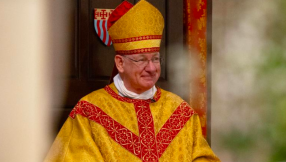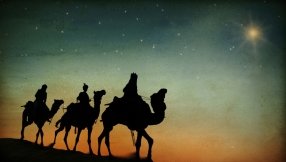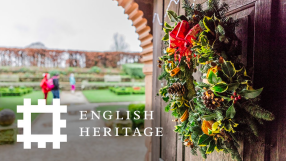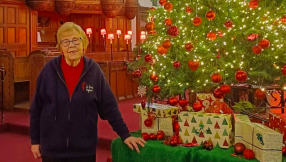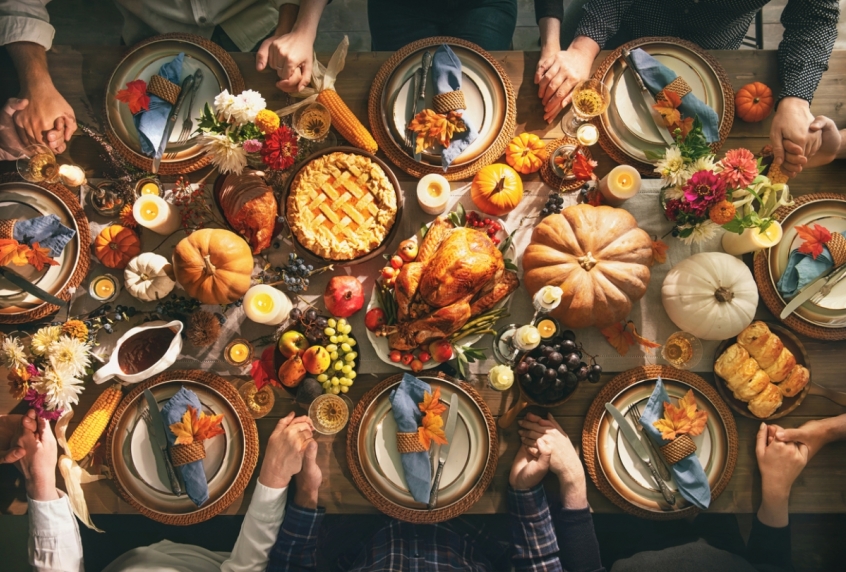
Every fourth Thursday of November, Americans everywhere, whether in the US or overseas mark Thanksgiving. This is the story ...
Meaning of Thanksgiving
The first known use of the word "thanksgiving" in an English text is from William Tyndale's translation of the New Testament in 1526. He uses the word in 2 Corinthians 4:15 and 9:11, in Colossians 4:2 and in 1 Timothy 4:4. In his spelling it appears as "thankesgevynge". William Shakespeare also uses the word in Love's Labour Lost in 1598.
Thanksgiving in the Bible
The theme of thanksgiving is found throughout the Bible. Leviticus 7:12-15 describes giving thanksgiving with unleavened cakes and bread. Leviticus 22:29 adds that it needs to be a freewill offering. In Nehemiah thanksgiving was given for the rebuilding of the walls of Jerusalem. Many of the Psalms were songs of thanksgiving. For example Psalm 95:2 says "Let us come before his presence with thanksgiving, And make a joyful noise unto him with psalms" (KJV).
In the New Testament St Paul mentions thanksgiving in many of his letters. For example he writes to the church at Philippi, "Be careful for nothing; but in every thing by prayer and supplication with thanksgiving let your requests be made known unto God" (Philippians 4:6 KJV).
Thanksgiving Days in England
The practice of Thanksgiving was common to English Protestant Christians, whether of the Anglican or Puritan tradition. In 1549, the Book of Common Prayer was created for use by the Church of England, and it provided for special Thanksgiving prayers for specific occasions such as thanksgiving at times of rain after drought, peace, deliverance from plague, safe passage, and for thanksgiving for plenty. In England, national Thanksgiving Days were called for many events, notably in 1588, for peace after the defeat of the Spanish Armada. In 1606, a Thanksgiving Day was called to mark the failure of the Gunpowder Plot. Days of thanksgiving were called in response to what was considered God's providence. For Puritans the focus of Thanksgiving was prayer.
Earliest North American Thanksgivings
English Protestant colonists destined for North America continued the thanksgiving tradition and held thanksgivings for safe passage and successful harvests. The first English thanksgiving in North America is credited to Sir Martin Frobisher in 1578. He held a Thanksgiving for a safe anchorage in what is now Canada, not the US. The first idea of an annual thanksgiving dates from 1619, when annual thanksgiving prayers were decreed in the charter of English settlers for Virginia, to mark the safe passage to America.
Actually the first Thanksgiving in North America may have happened even earlier and was actually Roman Catholic. In 1565, the Spanish explorer Pedro Menéndez de Avilé landed in what is now Florida and invited the local Timucua tribe to a feast, after holding a Catholic mass as a thanksgiving for safe passage.
Pilgrim Fathers
In 1620, a group of English Puritan Separatists headed to America aboard the Mayflower. When they landed they gave thanksgiving prayers for a safe passage after 66 days at sea. The following year, after they had had their first successful harvest, it would have been natural to hold a harvest thanksgiving. The 53 surviving settlers invited their native Americans friends to join them for a huge three-day feast. These native Americans, from the Wampanoag tribe, had shared their local planting, fishing and hunting knowledge, otherwise these English settlers would have died. The native Americans had their own traditions of celebrating harvest, and in this event in 1621, these two traditions may have coalesced.
The Leiden connection
The Pilgrims originated from England, but had already left England for Leiden in the Netherlands, where they had lived twelve years before sailing across the Atlantic. Leiden itself has its own ancient Thanksgiving which marks its relief from the siege of Leiden at the hands of the Spanish in 1574, which was held annually thereafter. The Pilgrims must have known it, and this may have influenced their own practice of Thanksgiving.
How we know the story
Most of what we know about these early American settlers, known now but not then as the Pilgrim Fathers, comes from the journal of William Bradford (1590-1657), who was one of them. Later in life as the first governor of Plymouth, Massachusetts, he wrote down "Of Plimoth Plantation", also known as "William Bradford's Journal", which tells the story of the Pilgrims from 1608 when they went to Leiden, through to 1647. As an eyewitness his account is considered credible. He recorded that the 53 surviving English settlers were joined by 90 members of the Wampanoag tribe, who brought five deer for venison, hunted fowl and joined them for a harvest feast. Turkeys were not mentioned, but might have been included. However, it was not until contents of "Of Plymouth Plantation" were published in the 1840s that the story became widely known.
Early Thanksgivings
Thanksgiving was not an annual event. Thanksgivings were called after significant events to thank God for what was considered to be his providence. The next thanksgiving was called by Governor Bradford in 1623 to mark rain after a period of drought. The first official day of Thanksgiving was called by the American Congress after the Battle of Saratoga during the War of Independence. The 18th December 1777 was declared a national day "for solemn Thanksgiving and praise". Later after the ratification of the constitution, George Washington, the first President of the newly independent United States, issued a national thanksgiving for 26th November 1789 "as a day of public thanksgiving and prayer, to be observed by acknowledging with grateful hearts the many and signal favours of Almighty God".
Origins of the Modern Thanksgiving
Having a harvest thanksgiving meal seemed to have been a local New England custom from the 1660s. In 1816 New Hampshire and Massachusetts declared different days in November as days of Thanksgiving. In 1817, New York state adopted an annual Thanksgiving holiday. However, the practice was not really known outside New England, until it was promoted by Sarah Josepha Hale (1788-1879) of New Hampshire.
Mrs Hale wrote a popular novel called Northwood: Or, a Tale of New England, which was first published in Boston in 1827, although she is more famous for writing the nursery rhyme "Mary Had a Little Lamb". In chapter 8 of Northwood, she describes what she called a "Yankee Thanksgiving" with "roasted turkey ... savoury stuffing ... innumerable bowls of gravy and plates of vegetables ... goose and pair of ducklings ... chicken pie ... celebrated pumpkin pie". For the second course, she described "plum pudding, custards, and pies of every name ... several kinds of rich cake, and a variety of sweatmeats and fruit". For drinks she described "excellent cider ... currant wine and ginger beer".
Later from 1837, she edited a magazine called Godey's Lady's Book, which ran from 1830 to 1878, and from the 1840s was the women's magazine with the largest circulation in the US. Mrs Hale publicised Thanksgiving and effectively re-invented it through articles in the magazine featuring recipes for Thanksgiving, such as roasted turkeys, stuffing and pumpkin pies. Her romanticized view of Thanksgiving set the tone in the minds of many American women and by the 1840s turkey, stuffing, squash and pie were standard Thanksgiving fare.
In her magazine she retold the story of the Pilgrim fathers, which until the 1840s was virtually unknown to most people. She instigated a letter writing campaign to influential people persuading them to make Thanksgiving a national annual event. Starting in 1846, she wrote to five successive American Presidents. In 1863, after she wrote to Abraham Lincoln, he was persuaded to make Thanksgiving an official national holiday, to be celebrated every last Thursday of November. As a result Sarah Hale became known as the "Mother of Thanksgiving".
Modern Thanksgiving
Since 1941, Thanksgiving has been held on the fourth Thursday in November, to avoid confusion when November sometimes has 5 Thursdays. These days Thanksgiving is a day when families, or sometimes groups of friends, get together. The US is a big country and many people live in a different state from other family members, and they travel long distances by car, train, bus or plane to be with their loved ones. As a result, the Thanksgiving period is typically the busiest travel time of the year.
The Thanksgiving meal
Today traditional foods include turkey, stuffing, gravy, sweet potatoes, squash, cornbread, mashed potatoes, and cranberry sauce. Annually over 40 million turkeys are eaten across the US on Thanksgiving. Many people serve pie for dessert at the end of the meal. Popular pies are pumpkin pie, pecan pie, and apple pie. Vegetarian Thanksgiving dinners have become increasingly popular.
Thanksgiving in Canada
Thanksgiving is almost a unique tradition from the US, but not quite. As mentioned earlier, the first recorded Thanksgiving took place in what is now Canada and is credited to Sir Martin Frobisher in 1578, who held a thanksgiving for a safe passage. Following vicious storms which battered the fleet, they anchored in what is now called Frobisher Bay on Baffin Island, now in the Canadian province of Nunavut. The Thanksgiving was an Anglican service with communion and was led by the ship's chaplain. The traditional date for it is 3rd September 1578.
Another thanksgiving is recorded in 1763 when Halifax held a thanksgiving for peace to mark the end of the Seven Years War, (known in the US as the French and Indian War), after which Quebec was ceded to the British Empire. In Canada, Thanksgiving was first observed as an annual event on 6 November 1879. It was typically observed on the second Monday in October. This date was made official in 1957, when the Canadian Parliament set this date as "a day of General Thanksgiving to Almighty God for the bountiful harvest with which Canada has been blessed." It is called Action de grâce in Quebec.
Thanksgiving Outside North America
Some other countries with historic links to the US also hold Thanksgiving. In Liberia Thanksgiving is the first Thursday in November. It is also held by some people in the Philippines and in Brazil and on some Caribbean islands.
Secular Thanksgiving
Although Thanksgiving has its historical roots in religious traditions, and has spiritual significance for many, today it is for most Americans a general secular holiday. Some American cities hold annual Thanksgiving parades most famously in New York, Detroit and Philadelphia. For other people it is about American football. American football games are held on Thanksgiving Day, and many American families turn on the television to watch a parade, and an American football game, interrupted by advertising. Ratings are at some of their highest on Thanksgiving Day and the advertising revenue is huge.
Black Friday
Because Thanksgiving falls on a Thursday many people take the following day off as well to make a long weekend, and many workplaces and schools are also closed that day. The day after Thanksgiving has become known as Black Friday and it effectively marks the start of the Christmas shopping season in the United States, and it's the biggest shopping day. Increasingly American retailers outside the USA have also held Black Friday events and so it has become increasingly known throughout the world.
Christians and Thanksgiving
Thanksgiving came out of the Anglican tradition and was practised in New England by Puritans. Today for many American Christians, across all the denominations, Thanksgiving may take on a spiritual importance. American Christians may attend a special Thanksgiving service, and say prayers before the meal. The Revised Common Lectionary gives Scriptures to be read for Thanksgiving: Deuteronomy 26:1-11, which is about bringing firstfruits and tithes; Psalm 100 which is a short psalm for giving grateful praise; Philippians 4:4-9 which is about rejoicing; and John 6:25-35 where Jesus refers to himself as the Bread of Life.
Neil Rees is a publishing consultant, historian, freelance writer and speaker. He is also involved in youth work at his local village church, and guest preaching in churches of different denominations.










